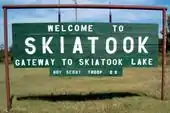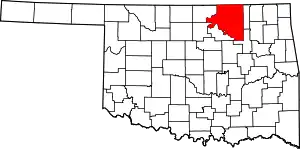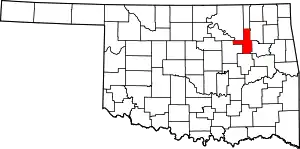Skiatook, Oklahoma
Skiatook (Skī·ǎ·tōōk or Skī·ǎ·tǒǒk versus Skī·tōōk or Skī·tǒǒk) is a city in Osage and Tulsa counties in the U.S. state of Oklahoma. It is located in the northeastern part of the state, approximately twenty miles north and west of Tulsa. The population was 7,397 at the 2010 census, an increase of 37.1 percent over the figure of 5,396 recorded in 2000.[5]
Skiatook, Oklahoma | |
|---|---|
| Nickname(s): Gateway to the Osage | |
| Motto(s): "Live Work Play Skiatook" | |
 Location of within Tulsa County, and the state of Oklahoma | |
| Coordinates: 36°22′2″N 96°2′50″W | |
| Country | United States |
| State | Oklahoma |
| Counties | Osage, Tulsa |
| Area | |
| • Total | 13.18 sq mi (34.14 km2) |
| • Land | 13.06 sq mi (33.83 km2) |
| • Water | 0.12 sq mi (0.31 km2) |
| Elevation | 646 ft (197 m) |
| Population (2010) | |
| • Total | 7,397 |
| • Estimate (2019)[2] | 8,052 |
| • Density | 616.49/sq mi (238.03/km2) |
| Time zone | UTC-6 (Central (CST)) |
| • Summer (DST) | UTC-5 (CDT) |
| ZIP code | 74070 |
| Area code(s) | 539/918 |
| FIPS code | 40-67850[3] |
| GNIS feature ID | 1098093[4] |
| Website | www.townofskiatook.com |

History
William C. Rogers, last hereditary Chief of the Cherokees, founded Skiatook in 1872, when he established a trading post in the Cherokee Nation just to the south of Bird Creek where the stream was easily crossed. When a post office was established in Rogers' store in the 1880s, the place was named Ski-a-took. An Osage Indian, Skiatooka, was a frequent trader at the post, so it has been suggested this may be the connection that resulted in the town's name. In 1892, the name was changed from Ski-a-took to its present form.[6]
Historical records have conflicting data as to the origin of Skiatook's name. One story is that the town was founded on land which was the home of a prominent Osage Indian, Skiatooka, and the community around his home was called Skiatooka's Settlement.
Another story is that the name was Cherokee in origin meaning either "big injun me" or describing a large man or a vast tract of land.[6]
Yet another story, told by local natives of Osage descent, is that after a tornado struck the settlement in its early years, while trying to describe to white settlers what had happened in broken English, natives used the phrase "sky-a-took". Literally meaning, the sky had taken the settlement. This story is at least four generations old – and in native tradition – handed down by word of mouth.
The first deed in town was granted to the Skiatook Bank, later known at the First National Bank, on December 18, 1904. Lumber was hauled in to build the bank building and in January 1905, the bank opened. Immediately after this day, despite the harsh winter, active construction began, and many buildings replaced shacks and tents.
Also in 1904, the Midland Valley Railroad was built through the area.[6] The route no longer exists, but has been converted from rail into the 14.5 mile Osage Prairie Trail linking Skiatook with Tulsa to the south.[7]
The weekly newspaper, The Skiatook Sentinel (now known as the Skiatook Journal), was first published in 1904. The town became incorporated during the summer of 1905,[6] with A.E. Townsend as its first mayor. By the fall of 1906, the residents had the conveniences of natural gas and public telephones.
After Oklahoma Statehood in 1907, construction began on permanent roads and bridges. Several country schools had been scattered throughout the area, and Skiatook Schools began in 1905. The first church building constructed in Skiatook was the First Christian Church in 1907. Before this, congregations met in several places in town, including homes and businesses.
Cement sidewalks were constructed between 1909 and 1910, and in 1912 Skiatook received water, sewer and electric light improvements. The area experienced much growth in the oil, gas and farm industries. Increased traffic through town warranted better streets, and by the fall of 1919, Skiatook had 15 blocks of continuous cement paved streets. In 1920, Skiatook had 2,000 residents and around 50 businesses.
A road to Tulsa was paved in the early 1920s, and with good roads leading out in all directions, Skiatook became known as the "Gateway to all points North, South, East and West". In the 1930s, Skiatook began purchasing water from Spavinaw, but the completion of Skiatook Lake in 1984 gave Skiatook its own water source.
Battle of Chustenahlah
The Battle of Chustenahlah[8] was fought just west of Skiatook, on December 26, 1861, during the Civil War. A band of 9,000 pro-Union Native Americans was forced to flee to Kansas in bitter cold and snow in what became known as the "Trail of Blood on the Ice." The victorious Confederates captured 160 women and children, 20 blacks, 30 wagons, 70 yoke of oxen, about 500 Indian horses, several hundred head of cattle, 100 sheep, and large quantities of supplies. Casualties were nine killed and 40 wounded for the Confederates. Colonel McIntosh in his official report estimated the Indians' loss as 250. A historical marker commemorates the battle.[6]
Demographics
| Historical population | |||
|---|---|---|---|
| Census | Pop. | %± | |
| 1910 | 606 | — | |
| 1920 | 1,653 | 172.8% | |
| 1930 | 1,789 | 8.2% | |
| 1940 | 1,496 | −16.4% | |
| 1950 | 1,734 | 15.9% | |
| 1960 | 2,503 | 44.3% | |
| 1970 | 2,930 | 17.1% | |
| 1980 | 3,596 | 22.7% | |
| 1990 | 4,910 | 36.5% | |
| 2000 | 5,396 | 9.9% | |
| 2010 | 7,397 | 37.1% | |
| 2019 (est.) | 8,052 | [2] | 8.9% |
| [9] | |||
As of the 2010 census, there were 7,397 people, 2,796 households, and 1,989 families residing in the town. The population density was 456.2 people per square mile (142.5/km2). There were 2,125 housing units at an average density of 145.3 per square mile (56.1/km2). The racial makeup of the town was 73.3% White, 0.6% African American, 17.7% Native American, 0.6% Asian, 0.01% Pacific Islander, 0.6% from other races, and 8.86% from two or more races. Hispanic or Latino of any race were 2.9% of the population.[10]
There were 2,796 households, out of which 36.1% had children under the age of 18 living with them, 49.6% were married couples living together, 15.0% had a female householder with no husband present, and 28.9% were non-families. 24.0% of all households were made up of individuals, and 10% had someone living alone who was 65 years of age or older. The average household size was 2.63 and the average family size was 3.11.
In the town, the population was spread out, with 31.0% under the age of 18, 9.3% from 18 to 24, 28.1% from 25 to 44, 18.2% from 45 to 64, and 13.3% who were 65 years of age or older. The median age was 32 years. For every 100 females, there were 85.9 males. For every 100 females age 18 and over, there were 81.9 males.
The median income for a household in the town was $39,617, and the median income for a family was $52,072. Males had a median income of $30,873 versus $21,419 for females. The per capita income for the town was $19,943. About 9.4% of families and 12.9% of the population were below the poverty line, including 17.7% of those under age 18 and 11.6% of those age 65 or over.[11]
Economy
Downtown Skiatook
The historic downtown area is home to a wide variety of stores, including antique dealers, a beer bar, specialty shops, Indian crafts, art galleries, dance studios, old-fashioned drug stores, a bakery, and a music store that features country music concerts every week. During the Pioneer Day festival people line the streets along Rogers Boulevard in downtown for the parade; in the past the street was blocked so a dance could be held in the evening, although this is no longer feasible due to the heavy traffic volume through town on Highway 20.
Skiatook has a master plan for the revitalization of its downtown.[12] One part is the formation of the Skiatook Main Street Association, a "Main Street program" which will help revitalize the downtown area with business growth, design guideline conformity, and deal with various issues that affect Skiatook's main street.[13]
Arts and culture
Skiatook Museum
Downtown is also home to the Skiatook Museum. The Skiatook Museum was established thanks to the people who kept mementos, scrapbooks, pictures, letters, and artifacts; such as C. H. Cleveland and Mrs. G. B. Epperson, who left the book "Skiatook 1872 to 1921."
The Skiatook Historical Society was organized in April 1976. The goal of the members was to preserve the interesting history of Skiatook from its beginning to the present time.
In 1988, after 5 moves, the Skiatook Museum moved into the home of pioneer doctor W. G. Phillips.[6] The home, built in 1912, contained his office. In 1910, Dr. Phillips settled in Skiatook and served the community for 50 years. His medical diploma and college graduation picture are on display at the museum.
The Skiatook Museum made Dr. Phillips' house its permanent home with the aid of the Oklahoma Historical Society, including grants to refurbish the house and set up display areas within its walls.
The museum board conducted a successful building fund campaign in 1999 and completed an addition to the home which has added much-needed space for the display of local historical documents, as well as furniture and other household items of the town's pioneers.
Historians, students and all those looking for their family tree, who are searching for Skiatook's past can view the personal papers, documents and photographs of the town's pioneer families, events and places at the museum. Also provided is a microfilm reader to enable visitors to research into newspapers dating back to April 1905, the date the first newspaper in town began publishing.
Annual events
Skiatook hosts several events throughout the year, including the Pioneer Days Festival, complete with a parade, fly-in, Chili cook-off, art show, tractor show, car show, delicious food from various vendors, rides, vintage planes, and a rodeo; the "Fantasy in the Sky" Fourth of July celebration with concerts, food, and fireworks at the local airport; a Bluegrass Festival; a fine art & quilt show in October; various fishing tournaments; and a Christmas parade.
Parks and recreation
Skiatook Lake, Skiatook Statuary (Producer of the World's Largest Ornamental Concrete, and the first producer to ship to Russia), Skiatook Museum, The Healing Rock, Civil War Battle Marker (Battle of Chustenahlah), Captain's Cemetery, Hillside Cemetery, View from Javine Hill, Horse and Cattle Ranches, Skiatook Airport, John Zink Scout Ranch, Herbert Pinc Auditorium, the newly constructed 103,000 sq ft (9,600 m2) arena (the Skiatook Multi-Purpose Activity Center) which will seat 6,000 people, Woodland Christmas Tree Farm, Vegetable and Fruit Market, Pecan and Flower Market, Community Building, Cedar Crest Golf course, CrossTimbers Resort & Marina, and Crystal Bay Marina and finally the hillside cemetery home of the witches grave.
Skiatook residents enjoy multiple recreational opportunities, including Osage Park, John Zink Park, Smith Park, the Skiatook Sports Park, soccer fields, tennis courts, a nine-hole golf course, a driving range, shooting range, and Skiatook Lake. There are numerous little leagues (football, baseball, softball, soccer) and an adult soccer league.
The Osage Prairie Trail was constructed with Vision 2025 funds, and this 14 miles (23 km) jogging and bike trail connects Skiatook to Tulsa's extensive bike and jogging trail system. The Skiatook community pool was opened in the 1950s, and provided swimming lessons to thousands of Skiatook children. Due to deteriorating conditions, the old pool was closed in 2001. The new pool opened to the public on June 2, 2007.[14]
Skiatook Lake
Skiatook Dam and Lake was authorized for construction by the Flood Control Act approved October 23, 1962 (87th Congress). It is one of five projects in the Bird Creek Basin plan recommended to meet the comprehensive water resources needs of the area. The Damsite is located on Hominy Creek about 5 miles (8 km) west of Skiatook in Osage County, Oklahoma. The project serves the purposes of flood control, water quality, water supply, recreation, and fish and wildlife management. The total cost of the project was approximately $120 million. It was completed in 1984. Elevated 714.0 feet (217.6 m) above sea level, the lake has a surface area of about 10,500 acres (42 km2) and 160 miles (260 km) of shoreline. Skiatook Lake has brought tremendous growth to the surrounding Skiatook area since its completion.
In 2010 Skiatook opened a $2.3 million park that features splash pads, new playground equipment and even a pond and walking trails.[15]
Osage Trail walking trail is 14.5 miles long, starting in Skiatook.[16]
The shoreline is accentuated by steep picturesque bluffs which offer fantastic views. Boating, hiking, swimming, camping, picnicking as well as hunting and fishing are all popular activities at the lake.
Sport fishing is very popular and Skiatook Lake has several annual fishing tournaments. Largemouth bass, black and white crappie, channel catfish, and several species of sunfish are plentiful in Skiatook Lake.
Whitetail deer, rabbit, squirrel, beaver, quail, and many more bird species are plentiful around the lake. Even a few coyote have been seen. During the seasons, about 8,000 acres (32 km2) of this land are open for hunting.
There are several places open to camping, including Tallchief Cove, Bull Creek and Twin Points campgrounds. Other parks on the lake include Blackdog Park, Osage Park, Quapaw Park, Hominy Landing and Skiatook Point.
About 1,800 acres (7.3 km2) of land around the lake have been set aside for public use areas. These areas provide roads, parking spaces, boat ramps, nature trails, picnicking and camping sites along with sanitary facilities. These areas remain attractive to the user and blend in with the natural landscape surrounding the lake.
Government
Skiatook has a city government with a 7-member city council and a City Manager. City public services include a full-time fire department, which also provides emergency medical service for Skiatook and the surrounding rural area (approx. 500 square miles (1,290 km2)); a full-time police department with 24-hour E911 communications center; and refuse service, sanitation and sewage. The city is responsible for a comprehensive city plan and for zoning.
In May, 2019, the city council voted unanimously for Roger Upton to serve as Mayor for the next two years. Herb Forbes will serve as Vice Mayor during the same period.[17]
Media
Skiatook has one newspaper, the Skiatook Journal. The paper is published every Wednesday. It is owned by BH Media Group.
Skiatook also has an entertainment tabloid. The Hub of Skiatook is a bi-monthly entertainment publication that spotlights local people, businesses, and events. Its Facebook page, https://www.facebook.com/TheHubSkiatook/, features regular videos of local content.
Skiatook in film
Parts of the 1983 film adaptation of S.E. Hinton's novel The Outsiders were filmed in locations around Skiatook, as was the movie The Eye of God.[18]
Notable people
Ronnie Dunn of the country music band Brooks & Dunn lived in Skiatook as a teenager.
Actor Wes Studi of films such as Dances with Wolves, The Last of the Mohicans, Geronimo: An American Legend, The New World, and Avatar spent a portion of his childhood years living with his family in Skiatook.
Joshua Morrow, star of "The Young and the Restless", attended Skiatook High School in the late 1980s.
Olympian Glen Dawson is from Skiatook.
References
- "2019 U.S. Gazetteer Files". United States Census Bureau. Retrieved July 28, 2020.
- "Population and Housing Unit Estimates". United States Census Bureau. May 24, 2020. Retrieved May 27, 2020.
- "U.S. Census website". United States Census Bureau. Retrieved 2008-01-31.
- "US Board on Geographic Names". United States Geological Survey. 2007-10-25. Retrieved 2008-01-31.
- "Skiatook, OK Population – Census 2010 and 2000 Interactive Map, Demographics, Statistics, Quick Facts – CensusViewer". Retrieved 12 January 2016.
- Anna Mae Henderson, "Skiatook," Encyclopedia of Oklahoma History and Culture. Accessed April 4, 2015.
- "Osage Prairie Trail". Rails to Trails Conservancy (US). Retrieved October 23, 2019.
- "On this date in the Civil War: December 26, 1861 – The Battle of Chustenahlah – This Week in the Civil War". This Week in the Civil War. Retrieved 12 January 2016.
- "Skiatook, Oklahoma (OK) ~ population data, races, housing & economy". Retrieved 12 January 2016.
- Data Access and Dissemination Systems (DADS). "American FactFinder – Results". Archived from the original on 21 May 2019. Retrieved 12 January 2016.
- Data Access and Dissemination Systems (DADS). "American FactFinder – Results". Archived from the original on 12 February 2020. Retrieved 12 January 2016.
- "Skiatook Downtown Revitalization Plan". City of Skiatook. Retrieved October 26, 2019.
- "Skiatook Town Plan". City of Skiatook. Retrieved October 26, 2019.
- Neighbor Newspapers – New pool ready to go, more staff needed
- "Archived copy". Archived from the original on 2010-12-03. Retrieved 2013-06-05.CS1 maint: archived copy as title (link)
- "INCOG – Tulsa, OK – Regional Partners – Regional Solutions". Retrieved 12 January 2016.
- [https:/ /www.tulsaworld.com/communities/skiatook/news/roger-upton-new-mayor/article_517e0edf-8cfb-5105-9672-0a97e56aaa18.html#tncms-source=infinity-scroll-summary-siderail-latest Chastain, Lindsey, "Roger Upton new mayor." Skiatook Journal. May 15, 2019.] Accessed June 12, 2019.
- "Eye of God (1997)". IMDb. 17 October 1997. Retrieved 12 January 2016.


